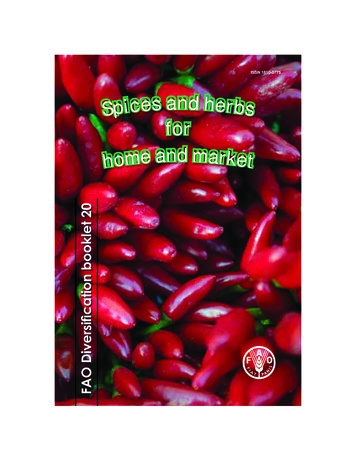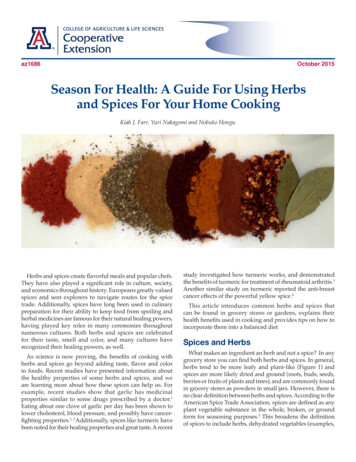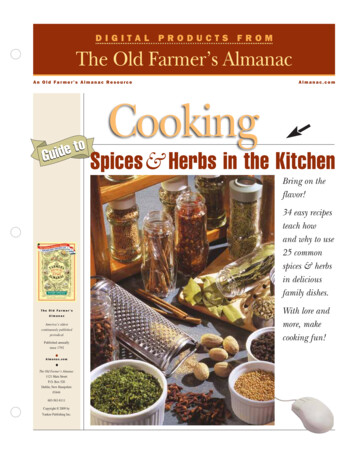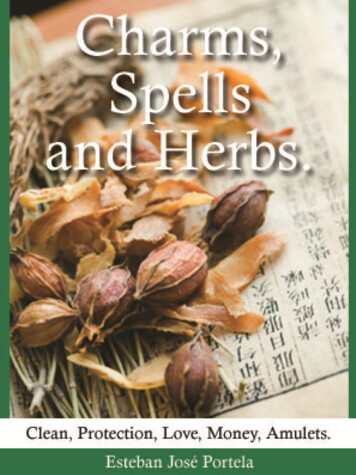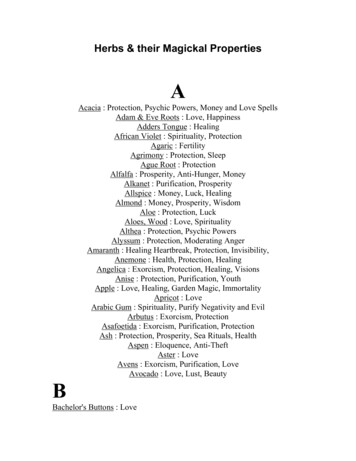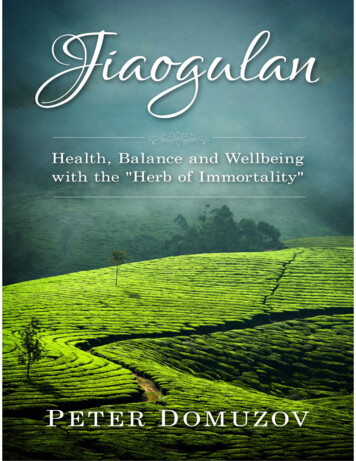
Transcription
Copyright 2016 by Majestic Herbs TMAll rights reserved. This book or any portion thereofmay not be reproduced or used in any manner whatsoeverwithout the express written permission of Majestic Herbs TMexcept for the use of brief quotations in a book review.Majestic Herbs TM1850 Lincoln Avenue, Suite 703Montreal, QC, Canada, H3H1H4http://MajesticHerbs.com
Table of Contents Introduction What is Jiaogulan? Discovery in Japan Discovery in China Jiaogulan the Adaptogen Jiaogulan the Supreme Antioxidant What Are Antioxidants? Exogenous Antioxidants Endogenous Antioxidants Superoxide Dismutase (SOD) Glutathione Peroxidase (Gpx) Youth and Longevity by Stimulating SOD and Gpx Production Jiaogulan Is The Best Antioxidant Jiaogulan as a Nitric Oxide Regulator Jiaogulan Promotes Cardiovascular Health Jiaogulan Prevents Arterial Damage Jiaogulan Prevents Plaque Buildup Jiaogulan Prevents Platelet Stickiness and Blood Clots Other Cardiovascular Benefits Jiaogulan and Cancer Jiaogulan Slows Down Aging and Increases Longevity Jiaogulan Prevents and Fights Diabetes Jiaogulan Protects and Boosts the Immune System Jiaogulan Protects and Strengthens the Nervous System Jiaogulan Improves Athletic Performance Other Health Benefits of Jiaogulan Anti-Anxiety and Anti-Stress Promotes Weight Loss Cleanses the Body From Toxins Protects the Liver
Protects and Improves Kidney Function Fights Respiratory Issues and Supports the Lungs Protects the Gastro-Intestinal System Balances Hormonal Function Protects and Benefits the Reproductive System Treats Insomnia Protects the Skin From Sun Damage Helps Against Psoriasis Anti-Viral, Anti-Fungal and Anti-Bacterial Headaches and Migraines Hangover Jiaogulan is Completely Safe and Non-Toxic Side Effects and Contraindications How to Prepare Jiaogulan Tea Recommended Daily Intake References
IntroductionWhen health is absent, wisdom cannot reveal itself, art cannot manifest,strength cannot fight, wealth becomes useless, and intelligence cannot beapplied.HerophilusI don’t know about you, but I’ve never met anyone who was both sick and happy.Your greatest wealth is good health. It is fundamental for a happy and fulfilling life.All the money and success in the world are meaningless if you don’t have your health.You need to be healthy to fully appreciate the truly important things in life; spending qualitytime with your family and friends, playing ball with your children on a Sunday afternoon, orgoing on a vacation to a foreign country.If you are like most people, chances are you’re overwhelmed and exhausted by the stress ofthe ever increasing pace and demands of everyday life.Unfortunately, sooner or later the combination of stress, poor diet, lack of exercise and sleep,and chemical toxins in the environment will affect you and your health will decline.Maybe you’re already one of the many millions of people around the world who suffer fromheart problems, high cholesterol, high blood pressure, cancer, diabetes, low immune function,low libido, impotence, chronic fatigue, depression, mental decline and other neurologicaldiseases?If so, you’re probably taking expensive medications whose side effects are sometimes worsethan the disease they’re supposed to control.Maybe you’re worried that you’ll be one of the 30 something percent of people who areexpected to get cancer in their lifetime?
Would you be interested in a natural and easy way to restore and maintain your overall healthand well-being, to look and feel younger, relieve stress, have more energy, stamina, sexualvigor and mental clarity?What if you could gain these benefits while at the same time preventing most of the diseasesthat plague our modern society?An ounce of prevention is worth a pound of cure.Benjamin FranklinWell, I have good news! A little known herb called Jiaogulan may just be your cup of healthyand delicious tea!It can completely change life for you and your loved ones.Keep reading to discover why many people say that if you had to pick just one supplementthat would have the greatest overall impact on your health, you should choose Jiaogulan.
What is Jiaogulan?Jiaogulan (Gynostemma pentaphyllum) is a climbing vine of the cucumber/gourd family nativeto certain parts of south and southeast Asia.Although it grows in a number of Asian countries, the only early historical documentation ofthe herb comes from China.Jiaogulan (pronounced “gee-ow-goo-lan”) was first documented at the beginning of the MingDynasty by Zhu Xiao, who described and sketched the herb in 1406 CE in the book MateriaMedica for Famine. However, he did not recognize Jiaogulan as a medicinal plant, but only asa food and dietary supplement during times of food shortage or famine.The earliest reference of using Jiaogulan as a medicine is found almost 2 centuries later, in1578, in the classical book Compendium of Materia Medica by Li Shi-Zen. The renownedherbalist was able to identify some of Jiaogulan’s medicinal properties and stated that theplant could be used to treat tumors, trauma, edema and pain of the pharynx and neck, andhematuria.Unfortunately, at the time Li Shi-Zen had mixed up Jiaogulan with an analogous herb calledWulianmei, and it wasn’t until 1848 that the two plants were clearly separated by Wu Qi-Jun inhis book Textual Investigation of Herbal Plants, which also included additional information onJiaogulan’s medicinal uses.Although Jiaogulan had been used for hundreds of years as a folk herb and health tonic in themountainous regions of southern China where it grows wild, it had remained virtuallyunknown in the rest of the country until the end of the 20th century. In addition, it was notincluded in the standard pharmacopoeia of Traditional Chinese Medicine (TCM), because theclassical system had evolved in central China – far from the herb’s native south – and thatmeant that TCM practitioners remained unfamiliar with the plant until relatively recent times.The people of southern China used Jiaogulan as an energizing tonic, drinking the tea beforework to increase their strength and endurance, and after work to relieve fatigue and promoterelaxation and good sleep. They recognized the herb as a rejuvenating and general healthelixir and took it to treat common colds and other infectious diseases. It is also said that manyof the inhabitants of villages in the Fanjing Mountain (Guizhou province) were living to 100years of age as a result of drinking Jiaogulan tea daily instead of the traditional green tea.They called the herb “xiancao”, or “The Immortality Herb”, and described it as being “Likeginseng, but better than ginseng”.In modern times, Jiaogulan was more or less independently discovered in the early 1970’s in
both Japan and China.Discovery in JapanIn Japan, Jiaogulan is called Amachazuru, which translates as “sweet tea vine” due to acomponent in the leaves that give it a mildly sweet taste. In fact, it was precisely the herb’ssweetness that initially triggered research in Japan by Dr. Masahiro Nagai, presently aprofessor of Pharmacognosy at Hoshi Pharmaceutical University, who was trying to findalternative sweeteners to sugar in the late 60’s and early 70’s.Upon analyzing the chemical compounds of Amachazuru in an effort to isolate the componentresponsible for its sweetness, Dr. Nagai made the first discovery in the scientific world ofchemicals contained in Gynostemma that are identical to some of the compounds found inPanax ginseng – even if the two plants are completely unrelated to each other – andannounced his findings in 1976 at the 23rd Meeting of the Japanese Society ofPharmacognosy in Hiroshima, Japan. This event turned out to mark the end of theinvestigation of the herb for its sweetness, and the beginning of research into its healthproperties.During that same period, Dr. Tsunematsu Takemoto, a Japanese scientist and a herbalmedicine research specialist, was looking into natural treatments for cancer and other stressinduced diseases, in addition to a sugar alternative. He had been concentrating his researchon Momordica grosvenori, a melon fruit of the cucumber/gourd family that was known for bothits sweetness and medicinal qualities. He became interested in this fruit because of itsreputation as the “precious fruit of longevity” and its popularity in Chinese medicine.One year after Dr. Nagai’s presentation, Dr. Takemoto and his team became aware of theresearch being done with Amachazuru, which is in the same family as the Momordica fruit hewas studying. He became very interested in further examining Gynostemma because of thesimilarity of the herb’s compounds to those found in Panax ginseng and the fact that it wasgrowing wild in the fields and mountains of Japan. Dr. Takemoto realized that he had possiblyfound, in a seemingly insignificant perennial weed, an inexpensive and readily availablehealth panacea right in his home country.Dr. Takemoto became very excited about this newly discovered herb and embarked on amission to uncover its full potential. He found that Gynostemma contained four kinds ofsaponins, the major beneficial chemical compounds, exactly like those in Panax ginseng (asof 2015 scientists have identified 9 identical saponins) and seventeen other kinds of saponinsvery similar to those in Panax ginseng. Over the next ten years he and his research groupidentified and named 82 saponins from Gynostemma (as of 2015 scientists have identified atleast 174 different saponins), whereas Panax ginseng has been found to contain only up to28 saponins.In 1984 Dr. Takemoto started conducting experiments that began to demonstrateGynostemma’s many health-supporting and medicinal benefits. He saw that the herb
increased the activity, strength, and endurance of mice in an exhaustive swimming test,demonstrated Jiaogulan’s effectiveness as a neoplasm or tumor inhibitor, and showed theherb’s adaptogenic ability to prevent the negative side effects of dexamethasone in hormonetreatment therapy.Although these findings were significant, they marked only the beginning of the extensiveresearch that would later take place on Gynostemma. Unfortunately, Dr. Takemoto, who hadbeen the driving force behind Jiaogulan research for over a decade, passed away in 1989and the energy to continue the research slowed down considerably in Japan for the timebeing.Discovery in ChinaInterest in Jiaogulan by the Chinese government and researchers was intensifying, however,sparked by the promising scientific studies coming out of Japan, as well as the results of thefirst Chinese nationwide population census in 1970. 1 The data revealed an abnormally highpercentage of people living to 100 years of age and extremely low incidence of cancer,senility and other serious diseases in certain villages of the Guizhou, Guangxi and Sichuanprovinces2,3,4.Curious about the reason for these intriguing results, the Chinese government assembled ascientific team from the Chinese Academy of Medical Sciences to conduct an investigation.The researchers considered genetics, climate, diet and various other potential factors.They eventually found out that the only common thread between the many centenarians wasthe consumption of a tea made from a wild vine that they praised as “Xiancao”, or “TheImmortality Herb”. The name given to the herb by the locals served as an important clue forthe scientists.As a result of this discovery, and encouraged by the Japanese research with Jiaogulan, theChinese government appointed Dr. Jialiu Liu to lead a team of 16 scientists to investigate theproperties of plants growing in the Mt. Fanjing Nature Reserve. After lengthy and extensivestudy of a large variety of herbs, they singled out Jiaogulan as the most promising plant forfurther research.Jiaogulan [is] an herb from my native southern China that I believe possesses the most wideranging benefits for human health and wellness of any plant yet discovered. This may seemlike a bold statement, but having studied this remarkable tonic herb for more than twentyyears, I can assure you that there is strong scientific support to back up my passion forJiaogulan My own experience with Jiaogulan began in 1987, when I was asked by the Guizhou
government to lead a team of 16 scientists to investigate the properties of plants from the Mt.Fanjing rain forest in southern China. After many years studying hundreds of herbs, weultimately came to the realization that Jiaogulan was not only the rainforest’s most preciousgift, but was in fact nature’s greatest treasure. We began to use Jiaogulan in our medicaluniversity hospital with great success for a wide variety of conditions, and before long, it wasalso being used at numerous other hospitals throughout China. This attracted the excitedattention of scientists around the world, and today there are more than 300 studies andresearch papers on Jiaogulan from China, Japan, Ireland, Germany, Italy, the CzechRepublic, and even the United States.Dr. Jialiu Liu, “Father” of JiaogulanToday, more and more countries and institutions have joined the research effort on thisincredible plant.Research into Jiaogulan over the past 40 years has uncovered so many health benefits thatat first it’s difficult not to react with disbelief. We provide references to a subset of thehundreds of scientific studies that support our claims, so you can examine them further ifinterested.
Jiaogulan the AdaptogenAdaptogens are rare and remarkable plants that increase the body’s ability to counter andresist physical, chemical, biological, emotional, and environmental stressors by raisingnonspecific resistance toward such stress. They decrease the organism’s susceptibility toillness by allowing it to “adapt” to the stressful circumstances.Adaptogens support normal metabolism, help restore balance to the immune, nervous, andendocrine systems, and allow the body to maintain optimal homeostasis. They usually alsobenefit the liver, cardiovascular system, kidneys, and pancreas.For a plant to be qualified as an adaptogen, it must meet the following 3 criteria as defined byIsrael I. Berkhman, PhD, and Dr. I. V. Dardymov in 1968:1. It is Nontoxic An adaptogen is nontoxic to the recipient. It must cause minimal side effects onphysical or mental health.2. Increases Resistance to Stress An adaptogen produces a nonspecific response in the body - an increase in thepower of resistance against multiple stressors including physical, chemical, orbiological agents in multiple nonspecific ways, including the building of a reserve of“adaptive energy”. This reserve is then used when an actual stressor arises,instead of depleting the cells of vital energy.
3. Has a Normalizing Effect An adaptogen is “intelligent” in that it has a normalizing influence on physiology,regardless of the direction of change from the normal state caused by the stressor.This normalizing influence implies the capability of adaptogens for a bidirectionaleffect on physiological function. They are capable of either toning down orstrengthening the activity of multiple systems, including the neuro-endocrine andimmune systems, depending on the need. For example, if a person with high bloodpressure is given Jiaogulan, their blood pressure will drop. If on the other hand theirblood pressure is below normal, it will raise.When Dr. Berkhman was studying adaptogens, he discovered that the active compounds inmost of them were a particular class of chemical compounds called triterpenoid saponins,which had very low toxicity and little addictive potential.Some of these triterpenoid saponins have been identified as having adaptogenic properties,while others were found to have anti-inflammatory, hepatoprotective (protecting the liver),adrenal gland strengthening, and immune system modulating effects. 2Jiaogulan is a premier adaptogen, and has been described as “Like Ginseng, but better thanGinseng” because of the energizing effect both plants have on the body.However, while Ginseng is often poorly tolerated and can cause insomnia, tachycardia andnervousness, Jiaogulan has the opposite effects because it is a superior adaptogen.This is because while Panax Ginseng contains up to 28 different saponins 5 (calledpanaxosides or ginsenosides), as of 2015 scientists have isolated 174 of them fromGynostemma (called gypenosides), nine of which are identical to those of Panax Ginseng. 6,7That’s over 6 times as many of these health-promoting and balancing chemicals!In fact, Jiaogulan has the widest spectrum of saponins of any known plant in the world by far!This makes it a potentially more powerful and intelligent adaptogen with broader healtheffects than any other plant, and many have proclaimed it “The King of Adaptogens”.Over 40 years of scientific research done so far on Gynostemma seems to support thispossibility.
Jiaogulan the Supreme AntioxidantOf all the antioxidant rich foods, teas, herbs, vitamins and supplements in the world that havebeen studied by man, Jiaogulan unlike any other and is by far the best antioxidantsupplement that you can take.This sounds like quite an extraordinary claim, and as the saying goes, extraordinary claimsrequire extraordinary evidence.Here we will provide you with such evidence and explain why saying Jiaogulan is THE bestantioxidant supplement ever discovered is not an exaggeration, but a scientific fact.But first, we need to understand just what antioxidants are, their different types, and theirfunction in the body.What Are Antioxidants?Antioxidants came to public attention in the 1990’s, when scientists began to understand freeradical damage.Free radicals are atoms or molecules that are unstable and highly reactive with other cellularstructures because they contain unpaired electrons.Free radicals can cause damage to parts of cells such as DNA, proteins, lipids, and cellmembranes by stealing their electrons through a process called oxidation. (This is why freeradical damage is also called “oxidative damage”.)When free radicals oxidize important components of the cell, those components lose theirability to function normally, and this can cause the cell to die. Numerous studies indicate thatincreased production of free radicals causes or accelerates nerve cell injury and leads to
disease.In fact, a prevailing theory of disease and aging states that the gradual accumulation of freeradicals, and the harm they cause, is responsible for many of the adverse changes thateventually cause aging and diseases like cancer, Alzheimer’s, arthritis, heart and liverdisease, atherosclerosis, immune system decline, brain dysfunction, diabetes, and cataracts.Free radicals are not all bad however. They play a role in cell signaling and other beneficialprocesses when they exist in benign concentrations. The trouble begins when their numbersclimb, which may occur as a result of aging or when unnatural stressors like air pollution,pesticides, smoking, alcohol, stress, etc. are present.Antioxidants are intimately involved in the prevention of cellular damage caused by freeradicals. They are molecules that can safely interact with free radicals and neutralize thembefore vital molecules are damaged.Antioxidants can be either exogenous (also known as external or secondary), like those foundin foods and vitamins, or endogenous (also known as internal or primary), which are thoseproduced by your own body. Endogenous antioxidants are MUCH more powerful free radicalfighters than those you can get from your diet, like Vitamin C and E.Exogenous AntioxidantsPeople in general are only aware of dietary antioxidants – the kind that can be found in foodslike fruits and vegetables, drinks like green tea and coffee, and antioxidant supplements in theform of pills and capsules.There are thousands of dietary antioxidants, but the most common ones are vitamins A, C,and E, lycopene, and beta-carotene.Eating whole fruits, vegetables, and whole grains — all rich in networks of antioxidants andtheir helper molecules — protects against many diseases and premature aging.And as we get older, it becomes more and more important to eat plenty of foods rich inantioxidants.This is because our body’s natural defenses against free radicals diminish as we age, and soincreasingly we need outside help in our battle against oxidation – the primary cause ofdisease and aging.When you factor in environmental pollution, toxins, stress, and bad habits like smoking,
proper diet becomes doubly important.However, proper diet alone will eventually be insufficient and sooner or later we are alldestined to succumb to the onslaught of free radicals.Unless (Hint: This is where Jiaogulan comes in! )While antioxidants can also be produced artificially and consumed in supplement form,studies on the effectiveness of supplements have been inconclusive.It seems like they only provide limited benefits, if any, and in some cases can even bepotentially harmful! 8, 9Endogenous AntioxidantsFew people are even aware of them, but endogenous antioxidants are your body’s naturaland primary defense against free radicals.There are 5 types of antioxidants produced by the body: superoxide dismatuse (SOD), alphalipoic acid (ALA), coenzyme Q10 (CoQ10), catalase (CAT), and glutathione peroxidase (Gpx).Of these, the three most important ones are SOD, Gpx, and CAT, in that order.Endogenous antioxidants are literally hundreds and thousands of times more powerful freeradical scavengers than ANY dietary antioxidant out there.These antioxidants are the reason why when we are younger, we can be healthy even if wedon’t know what a fruit or vegetable tastes like.Unfortunately, our ability to produce them gradually decreases with age.For years, scientists have sought ways to increase our levels of SOD and Gpx, since theseare the most powerful antioxidants in existence.While Gpx levels can be temporarily raised through special diet and exercise, the samecannot be said about SOD.
Superoxide Dismutase (SOD)The problem is that while some foods and plants contain SOD naturally, when it is ingested inthe body it is quickly destroyed by stomach acids and intestinal enzymes, so virtually noneenters the bloodstream.Until the discovery of Jiaogulan, no natural and effective ways of boosting SOD levels hadbeen found.Superoxide dismutase is arguably the body’s most crucial antioxidant, since it is responsiblefor disarming the most dangerous and most common free radicals of all – the highly reactivesuperoxide radicals (oxygen with an extra electron).Superoxide radicals are strongly associated with the development of a number ofdegenerative diseases, including atherosclerosis, stroke, heart attack, neurological disorders,chronic and acute inflammatory conditions, chronic pain associated with inflammation,neurological disorders like Alzheimer’s and Parkinson’s, lung pathologies, and various otherage-related disorders.10, 11, 12, 13, 14As an extreme example, mice that have been genetically engineered to be unable to produceSOD willdie within days of being born from massive free radical damage. 17On the other hand, studies have shown a strong correlation between SOD levels in variousanimal species and their longevity.Research conducted in the early 1980’s by Richard Cutler at the Gerontology ResearchCenter at the National Institute of Health showed that mammals who produced higher levelsof SOD lived longer than those with lower SOD levels. 15, 16Dr. Cutler’s research showed that mice and rodents have the lowest SOD levels amongmammals, and that SOD levels are highest among more highly evolved mammals, withhumans displaying the highest relative SOD levels.Humans produce an average of 90 mcg/ml (micrograms per milliliter) of SOD and live anaverage of around 80 years. Our closest primate relatives, chimpanzees, produce 40 mcg/mlof SOD and live an average of only 40 years.In another example, pigeons live about 12 times longer than rats, even though they weigh thesame. The difference is that pigeons have high SOD levels and produce about half as manyfree radicals as rats.
Finally, fruit flies that have been genetically engineered to produce twice the normal level ofSOD live twice as long as ordinary fruit flies.Cutler’s cross-species investigations strongly suggest that SOD is a primary determinant oflongevity in mammals, and that increased SOD production plays a key role in the higher orderof mammals’ evolution from shorter to longer life spans.Glutathione Peroxidase (Gpx)Gpx is the other vitally important endogenous antioxidant, produced within each and everycell of your body.It prevents cell damage by neutralizing free radicals and maintains dietary antioxidants suchas vitamins C and E in their active forms so that they can keep fighting free radicals.Gpx plays a critical and integral part in detoxifying the body by binding to pesticides, heavymetals and other toxins until they are excreted.It also regulates protein and DNA synthesis and cell growth, and is critical in helping yourimmune system perform its role of fighting infections and preventing cancer.
Lastly, glutathione helps us reach peak mental and physical function by decreasing muscledamage, reducing recovery time, increasing strength and endurance, and shifting metabolismfrom fat production to muscle development.Just like with SOD, scientists have found a strong correlation between a species ororganism’s ability to produce glutathione and its longevity. 18, 19For example, studies have shown that high Gpx levels in the blood are typical in healthy andlong-lived people, whereas low levels are almost always found in people with poor health. 18, 20Jiaogulan Promotes Youth and Longevity by Stimulating SOD and Gpx ProductionJiaogulan’s remarkable ability to stimulate the body’s own production of both SOD andglutathione must be at the heart of the reason why it has been so strongly associated withanti-aging and longevity.Science has finally found the mechanism to explain how and why so many Jiaogulan users inChina lived to be 100 years old in good health, and why they called it “The Herb ofImmortality”.The stimulation of SOD and glutathione production may also be greatly responsible for thepreventive and therapeutic qualities the herb has.
A Guiyang Medical College human clinical trial with 610 healthy middle and advanced agepatients, aged 50 to 90, showed that SOD levels returned to their youthful levels after onlyone month of daily intake of 20 mg of gypenosides (the main active ingredients in Jiaogulan)!Those between 70 and 90 years of age saw an average decrease in the harmful superoxideand other radicals of 21.4% and an average increase in internally produced SOD of 282.8%,while in the 50 to 69 age group there was a 15.6% decrease in oxidant levels and a 116.1%increase in SOD concentrations! A control group not receiving gypenosides from Jiaogulandid not experience any change.22Two follow-up studies at Guiyang Medical College with 80 human patients aged 42-55suffering from endemic fluorosis (condition of fluorine intoxication brought about by excessiveingestion of fluorides) found that 10mg of Jiaogulan and Danshen extracts twice a day for 5months increased the level of SOD in their red blood cells by 34.1% from 847 ng/mgHb to1136 ng/mgHg on average. The SOD boosting effects was found to be solely caused byJiaogulan’s gypenosides and not Danshen.Furthermore, patients had a 19% decrease in Malondialdehyde (MDA) levels, which is usedas an indicator of oxidative stress (damage to cell structures due to excess of free radicals).There were no changes in the placebo group or a group that was administered Boraxinstead.23, 24In another 2-month double-blind experiment at the Shanghai Institute of Geriatrics, 51 elderlypatients were administered 60mg of Jiaogulan gypenosides daily for 2 months, while a controlgroup of 40 patients were given a placebo. This study too found a significant increase in SODlevels and significant decrease in cell damage from oxidation. In addition, the researcherssaw an improvement in the memory of the patients. None of these effects were observed inthe placebo group.25In addition to these landmark human studies, there has been a large number of animal and invitro studies demonstrating Jiaogulan’s ability to stimulate the production of SOD 21 – 56, Gpx 31,35, 37, 43, 44, 50, 51, 52, and CAT (catalase)44, 48, 50, 51.This ability to boost the organism’s own defenses against free radicals has been shown tohave a profound protective effects on the body as a whole.In particular, the increase in endogenous antioxidants by Jiaogulan was found to protect thecardiovascular21, 26, 27, 28, 29, 31, mmune26, 32, nervous31, 33, 34, 35 36,37, 38, 49, and reproductive39 systemsand various organs, such as the liver26, 40, 41, 42, 43, 44, 45, kidneys29, 31, stomach46, and skin47, 48.The increase of endogenous antioxidants was also found to have anti-inflammatory 29, 53, anticancer 53, 54 and anti-aging 32, 47, 48, 55, 56 effects, and to be beneficial for athletic performance and
faster recovery from exercise51.Jiaogulan Is The Best AntioxidantWe hope that it is now clear why we can confidently say that Jiaogulan is THE bestantioxidant supplement anybody can take.Jiaogulan is not like any other source of antioxidants, because it does not act in the same wayas fruits, vegetables, vitamins, and other herbs.Instead, its many saponins (the main active chemical compounds, also called gypenosides)have the ability to stimulate our bodies to produce the most powerful and vital antioxidants ofall – the endogenous antioxidants superoxide dismutase, glutathione peroxidase, andcatalase.This is extremely important, because these endogenous antioxidants are either impossible (inthe case of SOD), or difficult (in the case of Gpx and CAT) to obtain from our food.Furthermore, since our ability to produce these endogenous antioxidants decreasesdramatically with age, our bodies become increasingly defenseless against the onsla
the herb comes from China. Jiaogulan (pronounced “gee-ow-goo-lan”) was first documented at the beginning of the Ming Dynasty by Zhu Xiao, who described and sketched the herb in 1406 CE in the book Materia Medica for Famine. However, he did

